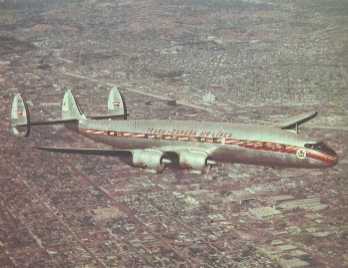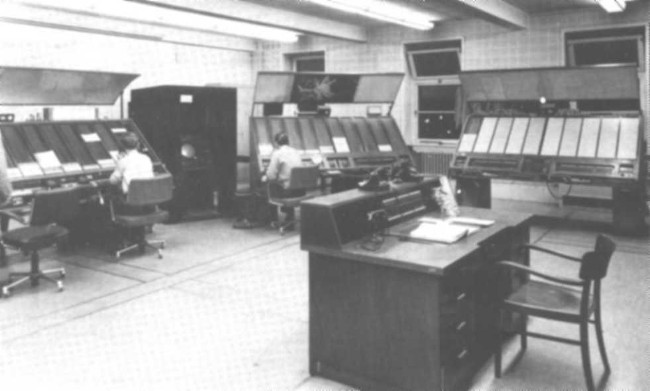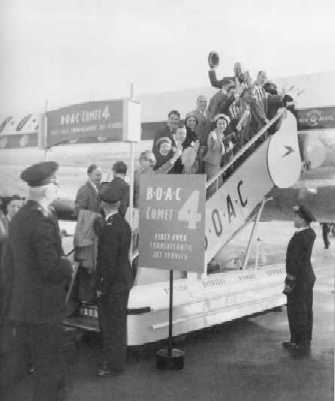EUR Region
The period between 1954 and 1958 (when the 4th EU R Regional Air
Navigation Meeting was held in Geneva) could best be described as a
period of preparation and transition, and this in a number of respects.
The most important of these was certainly that civil turbo-prop and
turbo-jet transport aircraft (Viscount, Comet, Caravelle etc.) began to
make their appearance in commercial operations, while the appearance of
other, bigger types loomed on the horizon. A further point was that air
tourism, mostly "to the sun" was gaining momentum because of favourable
economic conditions in States situated in the central and northern parts
of Western Europe.
 The Lockheed Super-Constellation operated
The Lockheed Super-Constellation operated
Trans-Canada's Montreal-London service in 1955On the technical side, the advent of the jet-aircraft was expected to
have a number of serious consequences for the air navigation system.
Briefly, these were:
the significant increase in cruising speed of the jet-aircraft over the
propeller-driven airline (around 400 knots = 750 km/h versus 250 knots =
450 km/h) permitted an appreciable reduction in flight time between any
two points and thus a higher utilisation of aircraft because they could
fly more often over any given distance. Therefore, more flights were
possible with the same number of aircraft;
- the higher speed required faster control action because, for any delay
in transmission, the distance travelled by the aircraft concerned was
greater (this was particularly critical for the closing speed in head-on
encounters of aircraft). Thus, the requirement for more and more
reliable position information, instantaneous direct communication
between pilot and controller and between controllers in adjacent control
positions and/or units became more pressing;
- because civil and military flights were expected to operate in the same
layers of the airspace, measures were required to keep civil controlled
flights separated from military flights, many of which were believed to
be uncontrollable due to the nature of their mission; and
- for the first time, economic factors entered prominently into the
technical handling of civil flights. This was due to the fact that the
fuel consumption of jet engines was extremely sensitive to the operating
altitude and speed
The higher speed and the consequent requirement for faster control
action would therefore result in an increase of traffic along
commercially attractive routes. At the same time because of the
sensitivity to altitude, traffic was compressed into a much smaller
layer of the airspace than had previously been the case. It was
therefore expected that more and more precise navigational guidance
would be required by the provision of more VOR's or VOR/DME's as well as
improved radar installations which covered not only the airspace around
high-density airports but provided also en-route coverage, at least
along the busier air routes. This had to be complemented by a complete
VHF air-ground communication coverage for direct pilot-controller voice
contacts and direct ground-ground telephone communications between
adjacent ATC units.

An air traffic control center in 1957
The speed of jet aircraft had however one other very significant effect
in the particular case of Europe. Due to the comparatively small
physical size of some European States, the time required by jet aircraft
to overfly these States shrunk to proportions which made, a control
intervention by ATC (change of route and/ or flight level) factually
impossible if this had not previously been co-ordinated with the ATC
services of an adjacent State. This meant that the European ATC system
had more and more to operate according to internationally agreed
concepts and procedures and that isolated national measures could no
longer be tolerated if the system was to work satisfactorily. Needless
to say that this in turn resulted in a considerable increase in the
co-ordination work of the European Office of ICAO because it offered the
best possibilities for this type of work.
 After its short-lived experience with the Comet 1,
After its short-lived experience with the Comet 1,
BOAC reintroduced jet services in October 1958 with
the Comet 4, first-ever transatlantic jet service
NAT Region
The continuous increase in air traffic was not only observed in the EU R
Region but affected also North Atlantic operations, so much, so that,
by 1956, a special NAT Regional Air Navigation Meeting was held in the
Paris Office which dealt mainly with communications and air traffic
control questions. Its main results were a number of improvements to the
ground-ground and air-ground communication provisions to allow a better
flow of traffic data and the formulation of more precise provisions
regarding the application of separation between flights operating over
the North Atlantic.
